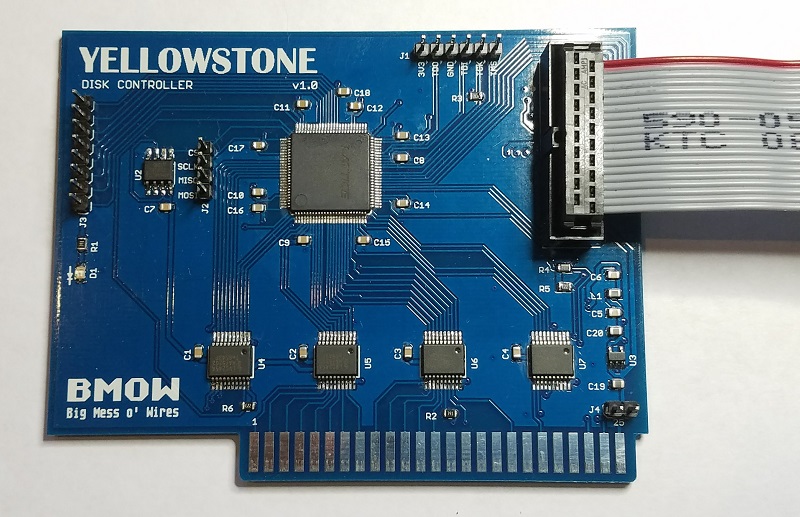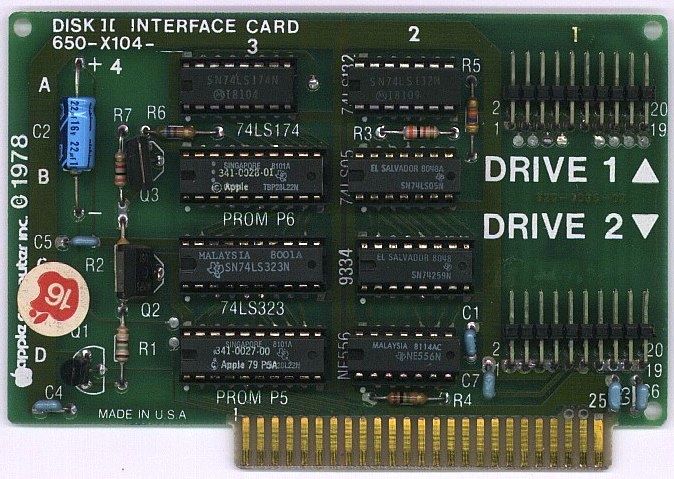Yellowstone 5.25 Inch and Smartport Support

Way back in 2017, I began development of Yellowstone, an FPGA-based disk controller card for the Apple II. It’s hard to believe it’s been almost four years. Sometimes I feel like I’m moving inch by inch along a journey of a thousand miles. But today I made some significant progress, and a milestone of sorts.
My earlier efforts were focused on duplicating the functionality of the Liron disk controller card (for Unidisk 3.5 and Smartport hard drives), and separately on the Disk II controller card for 5.25 inch drives. More recently I’ve been working on mirroring the functionality of the UDC disk controller, because it supports all of those types of drives as well as standard 3.5 inch drives, and it can automatically detect drive types. Today’s good news: when configured as a UDC, Yellowstone is now able to auto-detect, read, and write Unidisk, Smartport, and 5.25 inch drives! That’s basically everything the UDC offers except for 3.5 inch drive support, which is my next goal. It may sound like I’ve merely duplicated what I had before, but the UDC works quite differently from other disk controllers, and reaching this point means I’m getting closer to unlocking the full potential of a “universal” disk controller.

I’ve discovered some interesting things along the way. Many readers probably know that the Disk II controller card was Apple’s first disk controller, designed by WOZ and built entirely from simple off-the-shelf parts. Later Apple developed the IWM or “Integrated Wozniak Machine”, which did everything the Disk II controller could do, all in a single chip. But the IWM wasn’t just a replacement for the Disk II circuitry; it modified and extended it in a backwards-compatible way. The differences are subtle, but important. For example, if you write a byte to the Disk II controller while the disk is turned off, it has no effect. But if you write a byte to the IWM while the disk is turned off, it updates a configuration register that controls some interesting extra features.
I had been working towards creating an accurate IWM model, but what I discovered is that the code in the UDC’s ROM doesn’t really work with an IWM. It expects to be paired with some custom logic whose behavior is much closer to the original Disk II controller. It does strange-seeming things, like reading and writing from Smartport hard drives without ever asserting the drive’s enable signal. And it leaves a few other mysterious behaviors where I must guess at what’s intended. I’ve had to modify my Verilog design, breaking some of the IWM behaviors in order to match the UDC expectations. That makes me a little uneasy; I don’t really want to maintain two different designs. Fortunately the differences aren’t extensive.
3.5 inch drive support is the next step, but there’s so much to do beyond that. The real UDC card supports two independent disk connectors, but Yellowstone only has one. Some later versions of the UDC also support daisy-chaining drives, which I’d love to get working for Yellowstone too. Unfortunately there are UDC versions with Smartport support, and versions with daisy-chaining support, but none with both. Combining the two may be a major challenge.
After Yellowstone is functionally complete, there will still be plenty more work to do. I need to redesign the board to better isolate the FPGA from any 5V signals, and generally make it as robust and foolproof as possible. I need to decide what I’m doing about the required DB-19 female connectors, which are stupidly difficult to find, though I do have some. I need to revisit all that ROM packing stuff I described here recently, to see if I can’t squeeze everything into a more common FPGA with a lower cost. I probably need to build some kind of end-user reprogramming capability too, to allow for bug fixes or new features. I’m using a JTAG programmer and the Lattice development software, but that’s not a user-friendly solution. That could become a major project in its own right. And finally I need to design a self-test capability, or an external testing rig, that can be used to verify large numbers of boards (relatively speaking) after they’ve been assembled. At the rate I’m going, I’ll be busy for a long time!
Read 1 comment and join the conversation1 Comment so far
Leave a reply. For customer support issues, please use the Customer Support link instead of writing comments.


Great work!
This is one of those projects where everyone knows you can do it and you have all the skills but there are unnumbered expected and unexpected challenges, side quests and mini-projects along the way!
But we know you’ll get there!